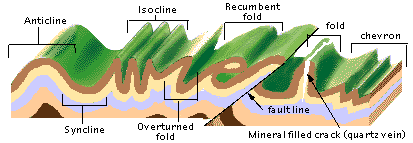From this point look at the rock outcrop to the East.
- Is this an entire fold? Or just one arm?
- Is this an anticline or syncline?
- What type of fold, symetrical, assymetrical?
- Is the fold overturned or recumbant?
The world is solid, hard and never changing. The rock of our foundation, building on a rock, solid as a rock. We hear these phrases and get the impression that nothing about these solid stones change. Right? Wrong. We can see the world around us and how it changes. This change will take you to a dramatic location. In fact where all the mountains in the area have the folds going north south, this canyon is a little different.
This canyon the folds change and dive into the earth, then were eroded away. The layers of stone that are horisontal tend to stay longer. Weathering eventually hits a hard stone, and can go no further. If the folds are all on their side, The weak stones tend to break away and leave the harder stones unsupported. So they break and erode faster.
Think of those stones as a tablecloth that you lay on a table. You can push it around and position it, as it slides. However place a heavy centerpiece on the table and when you push the tablecloth it will bunch up. It will fold. Simply at first, but push far enough and it will buckle and fold up on itself.
Rocks are the same way. They can crack, then heal themselves under pressure. Fold, bend and break. Sometimes faults will occur, and other times we will just see folding. Here we will see some of that folding, and talk about how geologists name the different types of folds.
A fold is a bend in the earth. Rocks under pressure and movement can fold in many different ways.
There most common description for folds is to determine if it is an anticline or a syncline. An antiline would be a fold that is domed, while a syncline is reversed.

Then they are usually referred to as a symmetrical or asymmetrical. After looking at the fold we look and see if the two sides are similar. Looking at the right side and the left side of the fold we try and see if it is a mirror image of the other side.
The other option after looking at those two is if they are overturned or recumbent. An overturned fault is one that is bent over. The other option is that they are recumbent. Meaning the fold has folded so far that it is approaching parallel to the ground and laying onto itself.